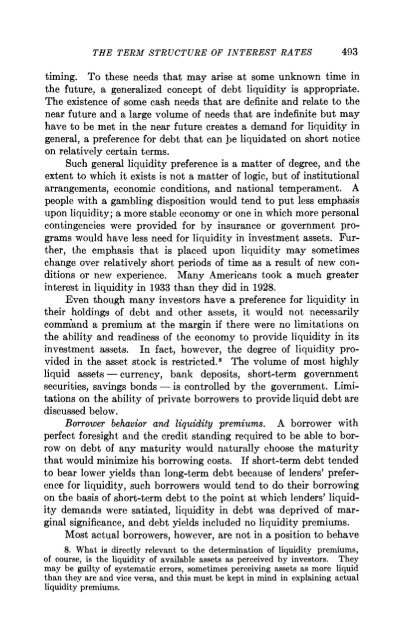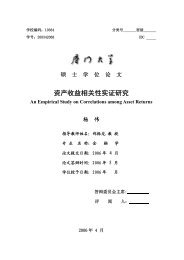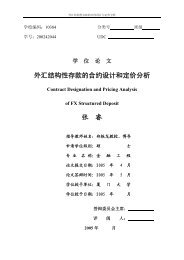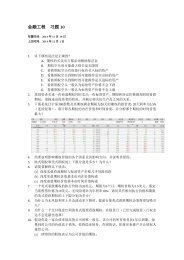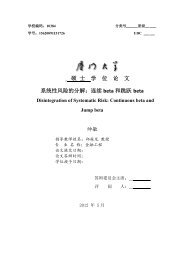The Term Structure of Interest Rates
The Term Structure of Interest Rates
The Term Structure of Interest Rates
Create successful ePaper yourself
Turn your PDF publications into a flip-book with our unique Google optimized e-Paper software.
THE TERM STRUCTURE OF INTEREST RATES 493<br />
timing. To these needs that may arise at some unknown time in<br />
the future, a generalized concept <strong>of</strong> debt liquidity is appropriate.<br />
<strong>The</strong> existence <strong>of</strong> some cash needs that are definite and relate to the<br />
near future and a large volume <strong>of</strong> needs that are indefinite but may<br />
have to be met in the near future creates a demand for liquidity in<br />
general, a preference for debt that can be liquidated on short notice<br />
on relatively certain terms.<br />
Such general liquidity preference is a matter <strong>of</strong> degree, and the<br />
extent to which it exists is not a matter <strong>of</strong> logic, but <strong>of</strong> institutional<br />
arrangements, economic conditions, and national temperament. A<br />
people with a gambling disposition would tend to put less emphasis<br />
upon liquidity; a more stable economy or one in which more personal<br />
contingencies were provided for by insurance or government programs<br />
would have less need for liquidity in investment assets. Further,<br />
the emphasis that is placed upon liquidity may sometimes<br />
change over relatively short periods <strong>of</strong> time as a result <strong>of</strong> new conditions<br />
or new experience. Many Americans took a much greater<br />
interest in liquidity in 1933 than they did in 1928.<br />
Even though many investors have a preference for liquidity in<br />
their holdings <strong>of</strong> debt and other assets, it would not necessarily<br />
command a premium at the margin if there were no limitations on<br />
the ability and readiness <strong>of</strong> the economy to provide liquidity in its<br />
investment assets. In fact, however, the degree <strong>of</strong> liquidity provided<br />
in the asset stock is restricted.8 <strong>The</strong> volume <strong>of</strong> most highly<br />
liquid assets - currency, bank deposits, short-term government<br />
securities, savings bonds - is controlled by the government. Limitations<br />
on the ability <strong>of</strong> private borrowers to provide liquid debt are<br />
discussed below.<br />
Borrower behavior and liquidity premiums. A borrower with<br />
perfect foresight and the credit standing required to be able to borrow<br />
on debt <strong>of</strong> any maturity would naturally choose the maturity<br />
that would minimize his borrowing costs. If short-term debt tended<br />
to bear lower yields than long-term debt because <strong>of</strong> lenders' preference<br />
for liquidity, such borrowers would tend to do their borrowing<br />
on the basis <strong>of</strong> short-term debt to the point at which lenders' liquidity<br />
demands were satiated, liquidity in debt was deprived <strong>of</strong> marginal<br />
significance, and debt yields included no liquidity premiums.<br />
Most actual borrowers, however, are not in a position to behave<br />
8. What is directly relevant to the determination <strong>of</strong> liquidity premiums,<br />
<strong>of</strong> course, is the liquidity <strong>of</strong> available assets as perceived by investors. <strong>The</strong>y<br />
may be guilty <strong>of</strong> systematic errors, sometimes perceiving assets as more liquid<br />
than they are and vice versa, and this must be kept in mind in explaining actual<br />
liquidity premiums.


